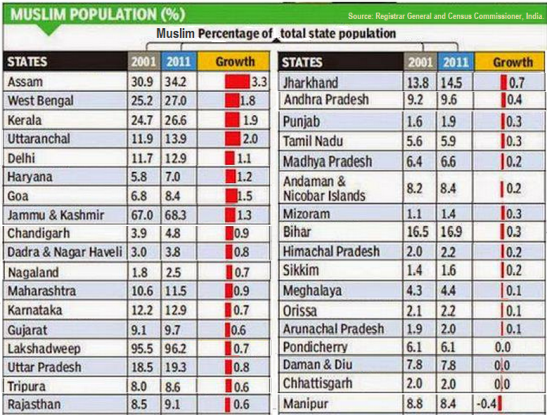Census India 2011 religious data published. Muslims have record decadal growth of 24.6 %, Hindus 16.8 %. Alarming 8% increase over Hindus in Muslim’s decadal growth.
Upananda Brahmachari | HENB | New Delhi | Aug 25, 2015:: Hindu Population in India falls under 80% since Independence first time while Muslim population in India is increasing with pace. The Muslim community has registered a moderate 0.8 per cent growth to touch 17.22 crore in the 10-year period between 2001 and 2011, up from 13.8 crore, while Hindu population showed a decline by 0.7 per cent at 96.63 crore during the period, according to the latest census data on religion.
As per the religious census data of 2011, released officially by the Registrar General and Census Commissioner on Tuesday, the total population in the country in 2011 was 121.09 crore.
Hindu population is 96.63 crores (79.8 per cent); Muslim 17.22 crores (14.2 per cent); Christian 2.78 crores (2.3 per cent); Sikh 2.08 crores (1.7 per cent); Buddhist 0.84 crores (0.7 per cent); Jain 0.45 crores (0.4 per cent), other religions and persuasions (ORP) 0.79 crores (0.7 per cent) and religion not stated 0.29 crores (0.2 per cent).
The proportion of Muslim population to total population has increased by 0.8 percentage point (PP) in 2011, the census data said.
The proportion of Hindu population to total population in 2011 has declined by 0.7 PP; the proportion of Sikh population has declined by 0.2 PP and the Buddhist population has declined by 0.1 PP during the decade 2001-2011.
There has been no significant change in the proportion of Christians and Jains.
As per 2001 census, India’s total population was 102 crores of which Hindu population comprised of 82.75 crore (80.45 per cent) and Muslims were 13.8 crore (13.4 per cent). The growth rate of population in the decade 2001-2011 was 17.7 per cent. The growth rate of population of the different religious communities in the same period was as Hindus: 16.8 per cent; Muslim: 24.6 per cent; Christian: 15.5 per cent; Sikh: 8.4 per cent; Buddhist: 6.1 per cent and Jain: 5.4 per cent.
The census report published on Tuesday shows an alarming 8% increase over Hindus in Muslim’s decadal growth. In Assam the Muslim growth touched a highest at 3.3 pc out of total state population including a remarkable growth in Uttaranchal (2.0 pc), Kerala (1.9 pc), West Bengal (1.8 pc), Goa (1.5 pc) and J&K (1.3 pc); whereas Manipur shows a minus of 0.4 pc.
This area wise growth of Muslim population resulted 53 highly Muslim populated districts, 15 Muslim majority parliamentary constituency and there are 350 Development Blocks in India where Muslims are in majority and over 150,000 rural and 10,000 urban and metro habitations are in India to establish a Muslim might to explore the pan-Islamic strength in India. A silent population Jihad in India is invading though the secular morons deny.
Moreover, this census report does not include crores of Bangladeshi Muslim infiltrators and thousands of Rohingya Muslims staying illegally in India.
This religion based census report of 2011 reveals that Hindus have been turned minority in Six Indian States and Union Territory viz. Jammu & Kashmir, Mizoram, Nagaland, Meghalaya, Arunachal Pradesh, Manipur and Lakshadweep (UT).
Mizoram has the least proportion of Hindus (2.75%), followed by Lakshadweep (2.77%), Nagaland (8.75%), Meghalaya (11.5%), J&K (28.4%), Arunachal (29%), Punjab (38.5%) and Manipur (41.4%).
Considering the traditional Hindu-Sikh Unity, the segregated 38.5% Hindu population in Punjab does not contain any feeling of Hindu minority there as such.
The distribution is total population by six major religious communities namely, Hindu, Muslim, Christian, Sikh, Buddhist, Jain besides ‘Other Religions and Persuasions’ and ‘Religion not stated’.
__With inputs from PTI.










